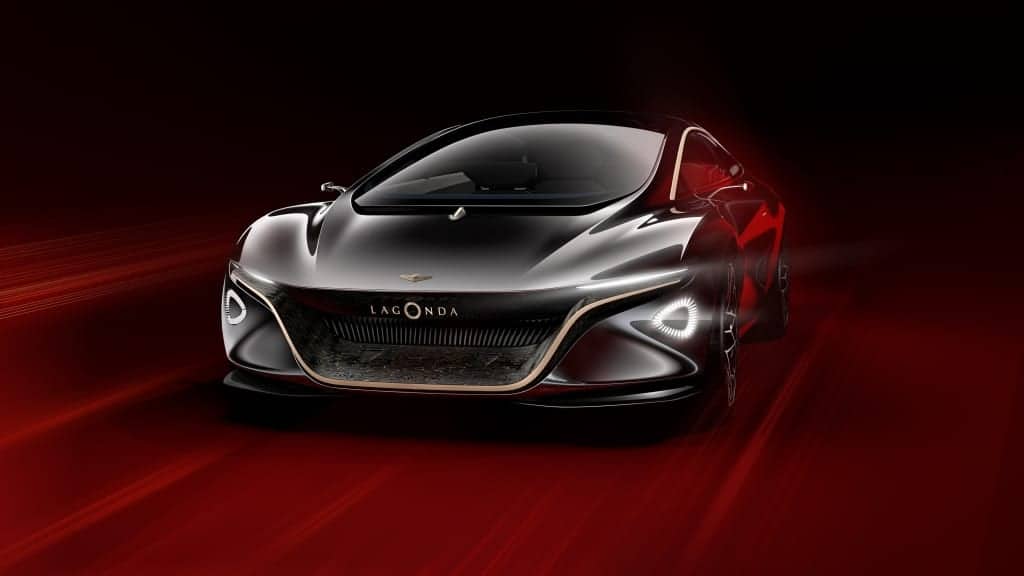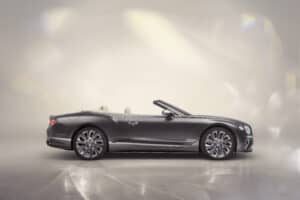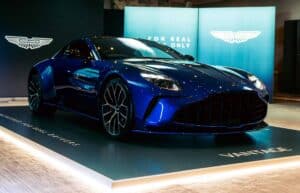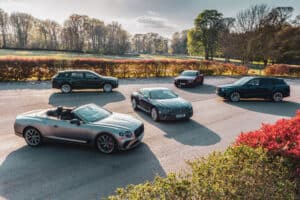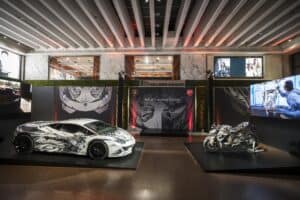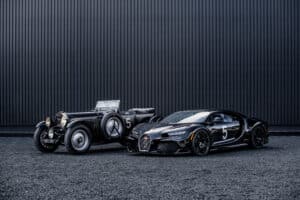Aston Martin is proud to present Lagonda Vision Concept, marking the beginning of a new range of state of the art, emission-free luxury vehicles. Production is planned to start in 2021.
Lagonda aims to be the world’s first zero emission luxury brand. It will confound traditional thinking and take full advantage of the latest advances in electrification and autonomous driving technologies, which amount to the biggest revolution in land-bound transportation since the invention of the car. Lagonda will show how true luxury and modern design, far from being diametrically opposed interests, can exist in total harmony and enhance each other’s most desirable characteristics.
Lagonda will show how true luxury and modern design, far from being diametrically opposed interests, can exist in total harmony and enhance each other’s most desirable characteristics.
‘We believe people associate luxury in their cars with a certain traditional and even old-fashioned approach because, to date, that is all that’s been available to them,’ commented Aston Martin President and Chief Executive Officer, Dr Andy Palmer. ‘Lagonda exists to challenge that thinking and prove that being modern and luxurious are not mutually exclusive concepts.’
Lagonda ‘Vision Concept’
The Lagonda ‘Vision Concept’ is a near future study that previews the design language that could potentially be seen in production Lagonda models as soon as 2021. Alongside the new concept, two 40 per cent scale models will be displayed, one coupe concept and one SUV concept, to illustrate how the Lagonda design language could be adapted for the future.
‘The Lagonda Vision Concept is an incredibly bold design statement,’ said Aston Martin EVP and Chief Creative Officer, Marek Reichman. ‘The electrification revolution means there is no longer any need for horse and carriage design, and our new concept shows the scope of design opportunities that open up once you no longer need to provide space for a large power source directly in front of the passenger compartment. In the Lagonda Vision Concept, the batteries occupy the floor of the car. Everything above that line belongs to us.’

The Vision Concept showcases Lagonda design ingenuity. Both far shorter and lower than traditional limousines, the exceptional space efficiency that has been achieved by its radical design means there is room inside for four adults, each of two metres height or more, to stretch out in luxurious comfort.
‘Lagonda has no need to occupy a huge amount of road space or make an ostentatious wealth statement,’ continues Reichman. ‘It is like comparing Concorde to the first class cabin of a conventional airliner. By ditching traditional architecture like Parthenon grilles and massive frontal areas, and by using electrical power, Lagonda design can still be distinctive and luxurious without being grandiose. It offers its customers a thoroughly modern, emission-free form of super-luxurious mobility.’
Far more than any orthodox design, the Lagonda Vision Concept was designed from the inside out because that is what the architecture allows. With no need to package a vast internal combustion engine, gearbox and transmission, Lagonda’s designers could optimise the interior down to the smallest detail and then build up the exterior of the car around it.

The Lagonda Vision Concept doesn’t have a bonnet because one is not required. But it still needs to travel through the air and to do so as efficiently as possible to preserve battery life, which is why its shape is so sleek and dynamic. ‘The shape of the Lagonda Vision Concept is the result of satisfying a number of different requirements,’ says Reichman. ‘The need to make a bold design statement, to establish Lagonda as a company of the future and to show how technological advancement can help liberate design too. So while Aston Martin design language can be seen as organic and natural, that of Lagonda is more sculptural, shocking and challenging. It is a shape formed by the collision of invisible forces, like those made by magnetic particles in an electrical current. The secret is to understand how to connect that shock and change to beautiful surfacing.’
For the interior Reichman and his team took further delight in defying convention, turning to the most traditional of households for the most visionary thinking. ‘How do you create a cabin that is at once unlike any other, capable of achieving a new level of luxury both in look and feel while staying true to Lagonda’s forward thinking vision? For me there was only one man for the job.’ The work of renowned English craftsman David Snowdon, has fascinated Reichman for years. His ability to marry materials, some very modern, others very established in ways that are never predictable held the key to the interior of the Lagonda Vision Concept.

‘When we first started working with David we showed him all these ideas we’d had for marquetry and leather on the inside and he said, “Let’s use different materials, materials people won’t expect even in isolation, let alone together.” Which is why the interior of the Lagonda Vision Concept uses not only ultra modern materials like carbon fibre and ceramics but also some of the oldest and finest that of late have rarely been used in the automotive sphere, like cashmeres and silks.’ The result is a cabin that surprises, shocks and fascinates, where silk carpets and hand woven wool upholstery live in perfect harmony with carbon fibre trim and functional ceramic tiles that open and close to alter the ventilation and adjust the volume of the music.

As well as working with David Snowdon, Marek enlisted the support of Savile Row tailors, Henry Poole for their expert knowledge in tailoring luxury materials. When the decision was made to use hand woven wool the master tailors of Henry Poole were able to assist in creating the patterns, cutting the material and the detailed finishing to ensure that a perfectly trimmed seat was achieved on the Lagonda ‘Vision Concept’.
Its design also means a new level of convenience and ease of use can be delivered. Because the majority of the car’s structural strength comes through its floor, it has been possible to use apertures in the body far larger than would be wise in conventional cars. As a result, the rear hinged back doors don’t just open outwards, the roof sections also open upwards to provide unprecedented ease of access. Occupants can therefore literally stand up inside and walk out of the car, or step straight into it. Similarly, the front seats are not mounted on conventional runners which always interfere with where those in the back would like to place their feet, but instead sit on cantilevered arms extending from the floor outside the seat frame providing a completely uncluttered floor area. And the seats are more like armchairs, with heavily bolstered arms because, given the choice people always use arms to lower and raise themselves from chairs.

The Lagonda Vision Concept also anticipates a world with a high level of autonomy. Its design is commensurate with level four autonomous driving, meaning the car is capable of driving itself in all routine circumstances and on all recognisable roads. As a result, the steering wheel can not only move from left to right hand drive according to need, in autonomous mode it can also retract entirely allowing front seat passengers to rotate through 180 degrees to engage in face to face conversation with those in the back. In the meantime, the car will not only have 360-degree awareness of the world around it, but also be fully connected to it, allowing occupants unprecedented access to bespoke concierge services and a level of connectivity and cyber-security few enjoy in their own homes, let along their cars.

‘For owners of true luxury cars, autonomy has existed for over a century, in a carbon-based form called a chauffeur,’ commented Palmer. ‘We imagine most Lagonda customers will choose to be driven, but whether by a person or a computer will be up to them. And if they want to drive themselves, the car will ensure that is a delightful and memorable experience too. Lagonda will provide that choice.’
The Lagonda Vision Concept has been configured to accept powerful solid state electric batteries enabling it to cover up to 400 real world miles between charges. That’s the distance from Los Angeles to San Francisco, London to Edinburgh or Berlin to Vienna without stopping. The concept has also has been designed to be compatible with the latest wireless conductive charging technology.

The car itself makes full use of Aston Martin’s world leading experience in multi-material bonding techniques, creating a structure that it at once supremely light for an all-electric luxury car, structurally stiff and, as we have seen incredibly space efficient. It will also make the most of its electric drive system to provide intelligent all-wheel drive, capable of delivering anything from 100 to zero per cent of available torque to any given wheel according to demand.
Lagonda: The Wonder of Travel
The Lagonda Vision Concept provides the first clues to the Lagonda models of the future. It embodies the vision to be a standalone marque that will break through long-standing boundaries and transform the way people perceive luxury transport. And as with the concept, this will be done through the use of cutting edge design, creating technologically radical, visually spectacular, thoroughly modern and ultra-luxurious vehicles that will overturn conventional thinking. Lagonda’s ambitions go beyond automotive, it is a luxury brand currently operating in the automotive sphere which can go anywhere and do anything that is consistent with the values of the brand.

Just like the Lagonda Vision Concept, production Lagonda models will not just be supremely spacious, cossetting and exquisitely appointed, but also bold and forward thinking, bristling with creativity and innovation from the way they are designed to the engineering they contain. They will prove that the old conflicts – those between high performance and zero emissions, technological sophistication and the purest luxury are conflicts no more. Lagonda believes the increase in new automotive technologies from efficient electrification to autonomous driving provides a unique opportunity for a new brand bearing one of the greatest names in motoring to rewrite a rulebook that has been allowed to stagnate for too long.

‘Ever since the start of the 20th century when petrol beat electricity and steam to become the fuel of the future, the evolution of the automobile has followed a continuous line both long and straight,’ commented Palmer. ‘No longer. A world of technological opportunity has now opened up, a world where those with the imagination, courage and determination to take a new path will thrive. With Lagonda we have the creativity, drive and the brand to make the most of this unique opportunity. We also have a clean canvas on which to realise our ambitions.’
Lagonda will use emergent technologies not to isolate their occupants from the experience of travel as do others, but to immerse them in its magic, enabling a whole new generation of enthusiasts and connoisseurs to rediscover the long lost joy of the journey. Once more the simple thrill of travel will become the justification for the journey, and no longer merely a means of reaching a destination.

‘There are some excellent products in the luxury car market today, but they are tied by their brands to traditional design execution,’ says Palmer. ‘Similarly, if you look at the most modern, technologically advanced cars on the market, they are defined by their technologies. By contrast Lagonda will be entirely strategic in its approach of technology, using it as a means to attain its goal of creating the world’s first ultra-modern luxury cars, and never as an end in itself.’
Above all Lagonda will remain faithful to the forward thinking, ever adventurous spirit of Wilbur Gunn, the Anglo-American engineer and entrepreneur who founded Lagonda in a greenhouse at his home in Staines to the west of London in 1904. A man whose talents stretched from opera singing to riverboat building, he named his company after the Lagonda Creek river that ran through the town of Springfield in his native Ohio. His cars were always innovative: for example, the 16/18hp model that won the Moscow to St Petersburg trial in 1910 boasted not only trailing arm rear suspension but a form of monocoque construction, decades before its advantages were realised by the bulk of the world’s car manufacturers. He succeeded because he refused to accept that the current way was the only way. Lagonda went on to become not only one of the most coveted car brands in the world, but among the most versatile too. In its 1930s heyday Lagonda was capable of producing V12-powered limousines fit for royalty, and sports cars strong and quick enough to win Le Mans, which one duly did in 1935. Bought by Aston Martin in 1947, Lagonda continued to innovate, never more so than with the extraordinary Aston Martin Lagonda of the 1980s and 1990s, to this day one of the most audacious and strikingly styled cars ever designed.

Modern Lagonda products will be inspired by these pioneering designs and, like them, steadfast in their focus on the future. ‘We see no limits for Lagonda,’ says Palmer, ‘it will be a brand for the restless, for those who are anything but happy with the status quo. It will produce cars that exploit technology, without being obsessed with it for its own sake. And It will enable Lagonda to redefine the concept of luxury within the automotive and other spheres.
‘The car has been the greatest liberating force humankind has invented, and at the time the journey was as important as the destination. All that has been lost over the last 100 years. Wherever you are in a Lagonda, whatever the journey and whichever seat you occupy, it will re-introduce you to the wonder of travel.’
Lagonda Heritage
NEVER STAND STILL
From our earliest beginnings to now, the story of Lagonda is one of movement. Our founder, Wilbur Gunn, was a restless pioneer who saw the world differently and constantly sought to push the boundaries of how we travel, inventing new and better ways to move.
An opera-singing machine engineer, Gunn was driven by a fascination for the possibilities of the latest technologies. That spirit of exploration and progressive innovation was the cornerstone of the Lagonda Motor Company. Founded in 1904, it was named for the fast-flowing Lagonda Creek river that ran through Gunn’s home town of Springfield, Ohio. Over one-hundred years later, his unique spirit of challenging conventions remains hard-coded in our DNA.
A BRAVE NEW WORLD
Gunn left America at the turn of the last century and settled in west London, where he began to perfect all sorts of machines to propel humans faster, further and better. From his glasshouse workshop, he made motorcycle and marine engines, conceiving of a double-expansion steam engine that powered the legendary “Giralda”, at that time the fastest steam yacht on the Thames.

Ever pioneering, it wasn’t long before Lagonda grew into a factory, creating tri-cars and four-wheeled carriages. “Torpedo”, a car which Gunn used to win the Moscow to St. Petersburg time trial of 1910, was decades ahead of its time. Inventive trailing arm rear suspension, unique monocoque construction, anti-roll bars and the first ever fly-off handbrake were just some of the visionary features that helped sell Lagondas all over the world.
THE JOY OF THE JOURNEY
Between the wars Lagonda exuded the highest standards in luxury travel, creating V12-powered limousines fit for royalty and featuring its patented Silent Travel design. Better still, Lagondas continued to set new speed and endurance benchmarks, notably winning Le Mans in 1935. Seeing its potential, David Brown purchased the company for £52,500 in 1947, forming Aston Martin Lagonda and forging ahead with all-new ultra-luxury cars like the exquisite four-door Lagonda Rapide.
INTO THE FUTURE
Technological advances captured the imagination of Lagonda like never before in the 1970s, leading to the creation of one of the most revolutionary cars the world has ever seen. The arresting William Towns designed Lagonda V8 was emblematic of the wonder of travel, fusing the very best technologies and electronics with the most opulent luxury to produce a phenomenally striking and balanced grand tourer.

Today, the world turns its attention once again to a revitalised Lagonda; inventing new and better ways to move, at the intersection of the very best of luxury and cutting-edge technology.
Key dates
| c1898 | Wilbur Gunn moves to England and establishes himself as a consulting engineer with a house in Staines that will gradually become the Lagonda factory. |
| 1899 | Wilbur Gunn founds the Lagonda Engineering Company to build marine engines. |
| c1900 | Manufacture of Lagonda motor cycles begins |
| 1903 | Wilbur Gunn (Lagonda) wins second-class award in the newly formed Auto-Cycle Club’s 1000-mile trial. Lagonda builds its first tricar, a 5-hp machine. |
| 1904 | The Lagonda firm is reformed as a limited liability company, the Lagonda Motor Co Ltd, on 18 May. |
| 1905 | Lagonda sells its first vee-twin tricar – “the motor cyclist’s Mercedes” |
| 1907 | Lagonda company put in receivership in April. Production suspended. |
| 1909 | A new start for Lagonda: 10-hp vee-twin car introduced, followed by a 14/16-hp four. A 16/18-hp replaces it by year end. An 18-hp Lagonda wins the Summer handicap race at Brooklands. |
| 1910 | Lagonda begins exports to Russia, with an agent in St Petersburg. A Lagonda driven by Wilbur Gunn wins a gold medal in the St Petersburg-Moscow- St Petersburg reliability trials. |
| 1911 | Lagonda introduces 20-hp four- and 30-hp six-cylinder models, though the Lagonda Motor Co Ltd is formally dissolved on 24 February. |
| 1912 | Lagonda Ltd formed to continue the business. |
| 1913 | The 11.1-hp 1099cc Lagonda introduced; its combined body/chassis pioneers unitary production and modular construction. |
| 1920 | Wilbur Gunn dies aged 61. |
| 1925 | Unit constructed models replaced by the all-new 14/60-hp with separate chassis-body construction. The high-set camshafts of the engine give similar benefits to twin-overhead camshafts without the mechanical complications. |
| 1926 | Frank Feeley joins the company straight from school and goes to work in the body shop. He will go on to design some of the most elegant Lagonda factory bodies until the 1950s.. |
| 1927 | 80-mph 2-litre Speed Model launched. |
| 1928 | Lagonda’s first entry at Le Mans sees D’Erlanger and Hawkes finish 11th. |
| 1929 | Tim Rose-Richards and the Hon. Brian E. “Bug” Lewis (2-litre Lagonda) fail to finish at Le Mans. |
| 1933 | The first 4.5-litre Lagonda, the Meadows-engined M45 is launched at the Olympia Motor Show. Lord de Clifford drives the prototype in a publicity run across Europe to Greece, beating the train to Brindisi by 14 hours. Lagonda Car Club established with factory support. First event is a meet at Hanworth Air Park (coincidentally where Aston Martins are built). |
| 1934 | The 3-litre is succeeded by the 3.5-litre. The Rapier goes into production and is launched at the Great Fosters Hotel at Egham. New models include the short-chassis 4.5-litre M45R Rapide and M35R, final incarnation of the 3-litre and 3.5-litre six cylinder line. |
| 1935 | British drivers Johnny Hindmarsh and Luis Fontés win Le Mans in a Lagonda M45R Rapide Lagonda is put into receivership. Alan Good reforms it as LG Motors and discontinues all the models, replacing them with the 4.5-litre LG45 designed by new chief engineer W.O. Bentley. The company is banned from using Bentley’s name in advertising by Rolls-Royce, which owns the Bentley marque. Rapier production is taken over by a new company, Rapier Cars Ltd. |
| 1936 | Spectacular new Bentley-designed V12 prototype makes its debut at the Motor Show. Launch of the spectacular LG45R Rapide, with Frank Feeley-designed bodywork. |
| 1937 | V12 production begins. Alan Hess averages 104.44 mph for an hour at Brooklands in LG45 “EPE 97”, setting a new record. |
| 1939 | Two special lightweight V12 Lagonda models finish third and fourth at Le Mans. |
| 1940 | The war interrupts V12 production. Final batch exported to America. During the war, Lagonda will produce armament materiel, including flame throwers. The two Le mans V12s, stored off-site, will be badly damaged by a flying bomb. |
| 1945 | Prototypes of a post-war Lagonda with a W.O. Bentley-designed twin-cam 2.6-litre engine are on the road, fitted with Cotal electrically-operated gearboxes. The new model is initially described as the “Lagonda-Bentley” but Lagonda forced to describe the new car as a “Lagonda designed under the supervision of W.O. Bentley” after a legal battle. |
| 1947 | Unable to proceed with production of the 2.6-litre LB6 because of post-war steel rationing, Lagonda is put up for sale and is bought by David Brown. Aston Martin Lagonda is formed. |
| 1949 | The Bentley-designed 2.6-litre Lagonda goes into production with a conventional David Brown gearbox. |
| 1950 | Frank Feeley designs prototype 3-litre Lagonda “Red Monster”. The 2.6-litre Lagonda engine is standardised for the production Aston Martin DB2 |
| 1953 | The Lagonda engine is enlarged to 3-litres and new body styles introduced. |
| 1954 | HRH Prince Philip buys the fourth production 3-litre DHC. |
| 1956 | Lagonda production is moved to Newport Pagnell along with Aston Martin. |
| 1958 | Lagonda production discontinued. |
| 1961 | New 4-litre Lagonda Rapide introduced, a four-door version of the Aston Martin DB4. |
| 1964 | End of 4-litre Lagonda production. |
| 1972 | Aston Martin Lagonda is taken over by Company Developments Ltd after Sir David Brown steps down. |
| 1974 | A new “Aston Martin Lagonda” model based on the 1971 four-door special, but with alloy wheels instead of wires, is launched. Only seven will be built |
| 1975 | Yet another group of new owners, led by Peter Sprague and George Minden, takes over Aston Martin Lagonda. |
| 1976 | Revolutionary new V8 Lagonda with unorthodox William Towns styling and electronic instrumentation is launched at Aston Clinton. |
| 1981 | Aston Martin Lagonda Ltd, owned by CH Industrials (48%), Pace Petroleum (48%) and Peter Cadbury (4%), takes over |
| 1983 | Automotive Investments and CH Industrials take over AML’ |
| 1984 | Automotive Investments sole owner of AML and subsequently Peter Livanos (75%) and Victor Gauntlett (25%). |
| 1985 | Tickford build long wheelbase Lagonda; just three will be produced. |
| 1987 | Ford Motor Company takes 75% ownership of AML with remainder split equally between Gauntlett and Livanos. The “Lagonda factor” is an important consideration in Ford’s decision. |
| 1993 | Ford takes full control of AML. |
| 2008 | Aston Martin announce plans to revive the Lagonda marque “to develop cars which can have a different character than a sports car… offering exclusive, luxurious and truly versatile products with high quality and usability…” |
| 2015 | Start of strictly limited production of the Lagonda Taraf, The car is the most expensive four-door saloon in the world at the time (April 2016). |

